Release Date: May 11th, 1940
Series: Merrie Melodies
Director: Chuck Jones
Story: Dave Monahan
Animation: Phil Monroe
Musical Direction: Carl Stalling
Starring: Margaret Hill-Talbot (Sniffles), [presumably] Purves Pullen (Animal sounds)
(You can find the short here or on HBO Max!)
Chuck Jones’ first Sniffles short of the year—much less decade—takes an experimental route in more ways than one. Firstly, it’s the first cartoon yet to star Sniffles and Sniffles alone, any secondary cast delegated to the various animals and insects in the wild. Secondly, it is a cartoon that chases atmosphere and ambience first and foremost rather than comedy or cutesy hijinks (mostly.)
If anything, this is the layout and background department’s cartoon more than Sniffles’; that’s not necessarily a bad thing. Taking a break from the city life, little Sniffles treks out into the countryside for a change of scenery. What is once awe-inspiring quickly turns overwhelming, especially for a mouse of such diminutive size, and he is thusly quick to embrace the mantra of “there’s no place like home”.
Storytelling is already a priority through the short’s establishing shot. Nestled behind the idyllic plains of the countryside is the distant city skyline—cold, gray and imposing compared to the warmer, softer greens, yellows and pinks in the landscape. Inclusion of the cityscape provides an added weight and incentive to Sniffles’ eponymous trip, a silent motive that needs no further context. His actions and adventures feel more purposeful with this in mind.
Such idyllic scenery requires a song number. Not from an off-screen chorus, but sung by Sniffles himself; a truck-in of the camera reveals the railroad tracks to be occupied by a certain singing mouse. Obscuring most of his face exaggerates his small height and grants a certain impressionable mysticism to his surroundings—the entire film is reliant on such a notion.
The song he sings appears to be an original; it’s virtually impossible to take the charisma out of Marjorie Hill-Talbot’s vocals, and while her voice is still very charming and warm, the song does at times slip into a habit of trying too hard to be cute. It’s most noticeable when Sniffles purposefully heaves a rather off-key, loud note, confirming the suspicions of the audience as his vocals occasionally slip into such territory throughout the song but not for a sustained amount of time. An endearing obnoxiousness, but equally loud in its attempts to be pegged as endearing. A bit of natural charm is consequently lost.
This is most apparent at the very end of the number; a crow perched on a wooden sign advertising the countryside bays, which prompts Sniffles to delightfully exclaim “A robin!” in a sort of ignorance that feels out of character rather than truly childish. Likewise, the song comes to an end purely through the orchestration rather than following it up with any more vocals. Sniffles’ empty, head-bobbing stares at the audience amidst this faux silence are uncanny at best.
Nevertheless, the song is a cute addition more than it isn’t. It cements Sniffles’ motives and clearly illustrates a very simple story: he wants to take a break and parse out the country. Both the sign occupied by the crow and the brochure in Sniffles’ pocket assure that he’s met his destination.
Even if the sequence does last about twice as long than what’s truly necessary, the camera panning back between the sign and the brochure (dimly painted fingernails on Sniffles’ gloves unfortunately noted—the background painters certainly enjoyed giving fingernails to characters who benefit greatly without them) is greatly informative just through sheer camera motion. Executing the pan on a slight arc with the camera turned at an angle likewise introduces an organic flow of motion that is surprisingly unhindered through typical jumps and jostles in similar pans. While looking back and forth four times is somewhat tiresome, especially at the glacial speeds in which it’s executed, it does succeed in immersing the audience into Sniffles’ own point of view. He seems more sympathetic by viewing things from his point of view.
No Sniffles cartoon is complete without an utterance of “Gee willikers!”
Mystification spurred by height disparities is employed once more as Sniffles hauls himself over the rail of the train tracks; diagonal angles once and slightly upward staging make the environments feel all the more imposing, big, all encompassing. Viewing the events at the same eye level as Sniffles rather than from above makes him and the filmmaking all the more sympathetic.
Wide shots along those lines are delegated to the next scene. If the prior scenes were intended to make the Sniffles’ environments seem big, then this scene follows the mission of making Sniffles himself seem small. Albeit slightly concealed by the moving camera pan, one can spot Sniffles struggling to catch his balance and sliding down a particularly sloping curve in the ground—little inconveniences are much bigger to him. A patch of flowering branches likewise seem to tower and loom; a “Gee whiz!” is spared in response.
A shot dedicated to Sniffles passing a tree in the distance foreshadows the direction taken by much of the cartoon’s remainder. Meticulously sculpted backgrounds and layouts that strategically exaggerate the heights of the characters to make them seem bigger or smaller—whichever the scene demands most. Even if Sniffles’ cel colors are somewhat off (most likely a failed attempt at mimicking the atmospheric perspective, faded colors conveying a further distance but only seem to apply to his fur), it doesn’t at all detract from the vibrancy of the flowers and toadstools surrounding the tree trunk. Wonderful, careful planning and framing.
Fuzzy flower buds seek to provide a more innocuous frame that is just as effective as the previous scene. Background details remain striking and intricate all the way through, but are careful to inform the audience’s eye and delegate focus to Sniffles when it’s most necessary.
Another “Gee willikers!” succinctly conveys Sniffles’ contentment.
Time for more backgrounds; while the sequence of Sniffles absorbing all of the sights and sounds gets somewhat repetitive and bloated, it’s a bloated repetition that is earned—the paintings are indisputably worthy of such a spotlight. Jones attempts to maintain the audience’s attention by allowing the shots to quicken in speed, intermittently returning back to a clearly elated Sniffles to introduce some variety. While that doesn’t eradicate the sequence entirely of its molasses timing, the crescendo in action, music, and behavior is certainly palpable.
Employment of binoculars seek to liven up the repetition by literally viewing the staging from a new lens. Same with spotted appearance of various wildlife—ducks, doves, and butterflies possess an imposing demeanor that is majestic rather than frightening.
That is instead reserved for the vicious beast Sniffles comes face to face with from his binoculars. Jones cleverly combines the two new novel aspects—binoculars and animals—as a large, red-rimmed eyed, curiously mustachioed insect stares menacingly right back into the binoculars. Sniffles and the audience both sharing the same point of view makes it seem as though the bug is staring into the soul of the audience just as much as it is with Sniffles. A much more effective result that way, even if it does read as a bit more on the domestic side today.
Perhaps such domesticity arrives only from knowing that the bug is no horrific fiend at all, but merely a tiny, unimposing fly. Character acting and the intricacies aren’t necessarily as big of a priority in this short than other Sniffles cartoons, but his startled take at the bug is a refreshing exception. Whether it be the subtleties of his fur standing on end or the more grandiose option of spastic flailing, a lot is certainly conveyed with few words.
“Shucks, only a little fly.” Given the solidity of Sniffles’ construction, slight smearing on the hands as he panics and general appearance of his wide-eyed take in particular, it wouldn’t be surprising to learn that Ken Harris was the animator responsible. That’s only speculation, of course—whoever it is nevertheless excelled through the aforementioned intricacies.
Ushering forth of a fade out and in indicates a shift in tone and momentum. Sure enough, the audience is acquainted with the sight of Sniffles setting up a hammock—mouse sized, of course—by hanging it on two tree twigs.
Animation of him tumbling into the hammock rather than just climbing inside is a more whimsical route, shamelessly tactile in its motion, but somewhat odd when juxtaposed with the forthcoming close-up. Really, it’s that the close-up doesn’t accommodate the leftover motion of the wide-shot. A lack of hook-up poses manufactures a slight jump in the pacing that isn’t intentional.
With a cartoon that places a focus on Sniffles and Sniffles alone, Jones and company almost seemed concerned as to how to sustain the audience’s attention. A conscious decision was made to prevent it from being a pantomime cartoon—instead, they run into the opposite issue of having too much dialogue.
Sniffles settling down for a nap seems to be the most concentrated example: “Yes, it certainly is… peaceful… this afternoon… right… out here…” Perhaps much of it is due to the structure of the sentence itself, his words trailing off as he tries to fight the impending sleep coming over him. It isn’t exactly excessive or egregious, but unnecessary; some of the various “Gee willikers” and “Gee whiz”es from before could also stand to be trimmed back. Not a major issue so much as it is a commentary, potentially providing insight as to what Jones and Dave Monahan were thinking and feeling. It seems like they were making conscious attempts to separate it from a pantomime short.
More background scenery is nevertheless in order as the camera pans along the birch tree, appearing ginormous when juxtaposed with Sniffles’ diminutive size.
That goes doubly for the woodpecker landing on the tree and doing what it does best.
Pedestrian and mild as the woodpecker promoting Sniffles to jostle and tumble around in his hammock may be, it is nevertheless cemented through tactile sound effects and staggered motion. Hollow pecking sounds are quick, upbeat, playful rather than droll. A slight echo makes them sound even more hollow and all encompassing than they already are. An absence of music to truly exaggerate the sound likewise supports such a notion.
“Hey, don’t do that!” Sniffles’ indignation is the very antithesis of threatening.
Jones asserts this as the hammock, right on cue, twirls itself up in a violent whirlwind. From the speed and control of the dry bush to the sheer concentration of the brush strokes alone, the visuals are certainly impressive. However, the initiation of the whirlwind suffers from ambiguous intent; if meant to be initiated by Sniffles’ standing on the hammock, it appears to jump, a sentient action rather than demanded by his weight. Showing Sniffles stumbling around upright may help to rectify this—likewise, if a belated result from the tremors of the woodpecker, then the hammock could stand to swing in a more frenzied direction when the pecks were actually unfurling.
Nevertheless, the journey isn’t a priority so much as the destination is; all is meant to lead up to a visible befuddled Sniffles entangled in the hammock, dubious blinks a plenty. Solidity of his construction is concise and tangible all through the entire sequence. Intricate angles on his tilted head and muzzle pay dividends, such a meticulousness demanded by his full body rotations upon the hammock’s entanglement.
A return to the close-up shot of the woodpecker in an attempt to clarify the next gag of Sniffles violently being drilled into the ground is somewhat unnecessary—the sheer sound of the woodpecker alone would be enough to add clarity. Especially when we had already seen the woodpecker once before. Regardless, it isn’t a major detractor, and the visual of Sniffles staring in nonplussed vacancy as his chin is violently bounced off the ground is comparatively more amusing than the mild hammock jostled. His hat flying off his head seeks to confirm the ferocity of the bird’s pecking.
The second outing with the hammock unfurling itself is likewise more successful through a stronger, clearer motivation. Spinning of the hammock persists for a second or two too many, but is admirable in its ability to convey so much through so little. Nothing but streaks of paint.
Brief dazed stumbles from Sniffles as he staggers over to disassemble his hammock seem to allude to a punchline that never approaches. Admittedly, that may be a side effect of comparisons to previous cartoons; his staggering—and, more explicitly, the contentedly dazed expression on his face—are synonymous to his drunken stumbles touted in Naughty but Mice, which inadvertently forms associations between the two. A resolution or end result is thusly beckoned that never comes; truthfully, it’s never needed.
Somewhat arbitrary dialogue ensues upon Sniffles setting up camp in a new spot, grumbling about that “darn ol’ birdy”, but is nevertheless charming and cute. Seeing as we’ve been privy to his hammock adventures once before, little time is spent detailing his preparations for a nap. Camera pans are a bigger focus—as is the giant crane that is now the proud owner of a hammock tied to its legs.
Its blinks are bloated beyond what is necessary, but instrumental in conveying that this is a living, breathing creature. Another succinct demonstration of how an ordinary waterfowl looks absolutely massive when viewed from the lens of a mouse. Even if pacing or acting has its lapses, the short prioritizes immersion and atmosphere—and to a great degree of success.
Rather than having the bird grow wise, flying into a garbled, squabbling frenzy, it remains completely oblivious. Thus spurs a confident, constructed close-up of Sniffles and the hammock being carried away as the bird walks; solidity on the animation drawings greatly savor the effect. The outcome of the scene would have not nearly as been as amusing nor rhythmic if the drawings were weaker in their construction. A profound sense of depth prevails.
So much so that the wide shot of the crane entering a pond almost looks crude in comparison. The animation isn’t crude by any means, but nevertheless provides a solid demonstration of just how high of a bar Jones sets for himself and his animators in terms of art direction. Even at their slowest, the earliest Jones cartoons are rarely ugly.
Carefully constructed animation is quick to make a comeback, courtesy of an underwater close-up. Jones would reprise a somewhat similar set-up in My Favorite Duck, executed with thrice the speed and thrice the comic potential. Regardless, gurgling bubble sounds (fitted with an appropriate musical accompaniment of “I’m Forever Blowing Bubbles”) bestow a permanence to Sniffles’ underwater presence; it ensures that he is actively involved and interacting with the environments rather than just a mere ploy to show off.
Presence of the crane is savored through Sniffles’ innocent ignorance. Rather than recognizing that he’s tied the hammock to the bird’s legs, he is instead occupied with the priority of escaping the water. Thus, the crane comes in handy, granting ease of access as Sniffles frantically scales his body and seeks refuge on his head.
Suspicions of there being any funny business afoot are only enabled when Sniffles accidentally pulls the bird’s eyelid down; whether it be from the wipe of a brow or a suspicious glance at the bird, Jones does embrace the pantomime route in this scene to success. Motives and thoughts of Sniffles are clear—likewise with the oxymoronic vacancy of the bird.
Highlights, shadows, and now reflections on the crane all uphold a careful artistic integrity Jones was eager to preserve. Coating the crane with such embellishments (but not Sniffles) almost provides it with a looming sense of authority; poor, meek little Sniffles doomed to a life of opaque coloring is a clear underdog when juxtaposed with the lush, grandiose, imposing coloring on the crane. A divide between the two characters and their roles is rightly established through such a menial detail.
This sort of grandiosity reaches its zenith through another point-of-view shot; realizing he’s got company, Sniffles accidentally slides off of the crane’s beak in the midst of his mad dash. Dangling from the tip of its bill grants the viewer a successfully unnerving shot from a mouse’s eye view. Synonymous to the unnerving close-up of the fly, the sheer length of the bird’s bill comes as the main attraction, whereas the presumed closeness of the fly was the focus prior. A strong parallel anchored through a successfully immersive sense of depth-perception—the exaggeration is as funny as it is believable. Color card backgrounds of gradient hues likewise seem to introduce a suffocating intimacy; no trees or wildlife in the background to distract and detract.
Such sparks another spill from Sniffles. Rather than engaging in a long, droll shot of his plummeting into the water, indications of his descent are conveyed purely through the camera trucking into a down shot of the pond. Jones would embrace such a technique and use it to even greater strengths in future cartoons.Though the crane’s eye direction is slightly off, that comes as a mere pittance when juxtaposed against a rather impressive display of animation (both in terms of the drawings and the motion) as the bird takes off. Treg Brown’s flapping sound effects greatly uphold the illusion—loud, violent flaps truly make the bird seem like a hulking terror rather than mere inhabitant of a pond.
Likewise, liberal application of dry brushing adds a tactile blur when viewed in motion. Ferocity of the wing flaps are greatly enhanced as a result. Likewise, Sniffles’ fears of the crane are justified—the filmmaking makes a point to lean on the sympathetic side, exaggerating the height and scale of the appropriate surroundings rather than constantly trying to dismiss Sniffles’ fears or ground the audience to reality.
Sniffles instead seeks to do that himself. Upon his recovery, an innocently menacing pair of eyes ogle back at him from the water. Polite hair-raising and hat-spinning takes ensue in tandem with his protest of “An alligator!”
“…An alligator.” For a few seconds, Sniffles’ brief confidentiality with the audience voices their own thoughts. By this point, the viewer has come to digest the general pattern—big scary things is actually not a big scary thing. So, perhaps with Sniffles’ awareness of the creature in question, that perhaps changes the formula on the axes; what if it is an alligator?
One last “Augh, A-AN ALLIGATOR!” acknowledges this as well. Through more frenzied, loose, motivated animation, Sniffles practically walks on water as he rushes ashore to safety. Water ripples haphazardly disappear halfway through their conception—not to an egregious extent in that it completely disrupts the scene, but it does provide the slightest jolt. Not something that is necessarily desired when stressing the rippling flow of the water.
Enter an escapee from an Ub Iwerks cartoon whose ugliness seems just as accidental as it is purposeful. The formula lives on.
Enter the third act of the cartoon, which provides a more grandiose reprise of the first. Both acts are united in their prioritization of background scenery and ambience first and foremost; indeed, 15 heavy, laden seconds are dedicated to illustrating the progression of twilight over the countryside.
While the sequence is on the slow side, it’s a slowness that is deserved and comfortable. One can almost physically sense Jones chasing the atmosphere. Colors are incredibly rich; the oranges and yellows at the first sight of the distant mountains warm the spine just as much as the deep purples evoke a loneliness that is as gentle as it is chilling.
Loneliness is just the right atmosphere Jones seeks to chase in the next segment of the cartoon—perhaps “vastness” or “overwhelmingness” would be more astute terms. Semantics aside, ambience is indisputable. Sniffles now huddles over a lone fire, wary glances over his shoulder indicating he’s on guard rather than truly relaxed. Staging his introduction so that his back is turned to the audience appears to isolate him further. It’s as though even the viewer could be a potential threat lurking in the dark unknown.
Shadows, color, and—most importantly—strategic framing all collaborate to place an almost unwilling spotlight on Sniffles. Placing him front and center in the screen automatically guides the eye of the viewer; the lurching, twisting trees in the background that arc around his frame likewise seek to draw the audience towards him further. The blaze of the fire cast dramatized shadows on his face; all signs point to Sniffles, who seems wary of such attention even on a metaphysical level.
Parts of the sequence border on the more talkative side. While the close-up of Sniffles huddled by the fire could arguably benefit from the moody intimacy of silence, allowing his furtive glances and equally foreboding music score to do the talking, his talking (and, later on, continuous utterances of “Oh!”) provides a comprehensive parallel to his earlier impressionable quips on the beauty of nature. Really, the entire sequence arrived as an antithetical bookend to the cartoon’s establishment.
“Yeah… it certainly is… peaceful… out here tonight… in the… dark, alright…” Character acting is rife in both the animation and Talbot’s vocals. Half of the chattiness in the dialogue stem from Sniffles’ attempts to rationalize with himself, trying to fight off the uneasiness that prevails. His addendum of “It’s sure… nice an’… dark, alright…” indicates a few lapses in his plans.
Sniffles Takes a Trip reaches its emotional and artistic zenith in a montage that directly parallels the one established when he first enters the countryside. Rather than lingering on long, bucolic images of the countryside, cutting between equally striking—though much more dark, imposing, and suffocating—shots is quicker in comparison. Frequent cutting back to Sniffles reveals a mouse who is overwhelmed with uncertainty rather than awe.
Emotions, especially those that are vicariously shared between Sniffles and the viewer, are a large proponent of the sequence’s success and mystification. In reality, the animals and wildlife of the countryside don’t outwardly display any intentions of hurting Sniffles. They seem to mind their own business, if anything. Regardless, that doesn’t allow the yellow glow of a caterpillar’s eyes, the uncannily human-shaped leering of a tree, the towering of a nearby owl, and the vast smattering of the unknown thinly concealed through various holes and hollows to read as any less frightening.
No, the insects and animals never harboring any sort of antagonistic tendencies towards Sniffles does not detract from his fear. If anything, the fast cutting, varied camera angles, intricate composition, repetition of shots, climax in music, and intimacy of the camera registry are validating. The audience experiences both the whimsy and petrification of Sniffles to an equal degree. Both share the same charismatic efficacy.
Charisma is moreover beneficially excessive in the slew of background shots that follow. Background shots following Sniffles as he makes a great escape back to the city, to be more specific. Color is just as integral to the storytelling as framing, cutting, and composition—in an incredibly gratifying twist, the once steely, slate hues representing the cold and unappealing city life are now trumped with an inviting, safe, glowing array of reds and oranges. Colors that evoke feelings of homeliness, comfort, attraction, it is a metaphorical representation of how inviting the familiarity reads. Many shots of the countryside are doused in inky blackness, representing an equally effective antithesis of cold, unwelcoming repellence.
Glimmering lights of the cityscape in the distance seem to manifest as a sort of winking motion; given the irony of the sign advertising the peace and quiet of the meadows, it certainly wouldn’t be out of place. The audience is thusly left to ponder the warmly ironic commentary in content bemusement as an iris encircles the sign.
Sniffles Takes a Trip shares a fair divide of pros and cons. If viewed with the desire for humor and intricate character acting, the short lacks in parts—none of the gags are exactly riotous, and certain quirks (awkward pacing, at times excessive dialogue, the very occasional bout of somewhat vague animation) may leave the audience asking for more in terms of Sniffles’ involvement. However, this explicitly is a cartoon that doesn’t seek to chase after such parameters. It is a cartoon about atmosphere, ambience, and sympathy first and foremost—in that regard, it exceeds expectations.
As mentioned in the introduction, the true protagonist of the film is the layout and background department. They are instrumental in ensuring Sniffles’ misadventures are appealing, endearing, and vicarious; the warped sense of scale that persists all throughout the cartoon truly does transform something as menial as a bird standing in a pond into a giant beast able to render occupied hammocks mobile. Much of the ending especially serves as a tangible example of storytelling unfurled purely through environments—Sniffles is only there to react rather than propel. Colors, framing, composition, cutting, and pacing all speak very loud volumes and allow the audience to connect the dots.
Pacing has a tendency to slip into glacial territory more often than not. However, given the emphasis on ambience and atmosphere, lingering is warranted—some of these aspects can’t be rushed. Jones wants the audience to chew and ingest the scenery just as much as Sniffles is, regardless of how the environments are metaphorically painted. 15 seconds for a sunset timelapse may seem excessive, but glancing at the paintings themselves immediately justifies why.
While it may not be one of Jones’ absolute best Sniffles cartoons, it’s certainly one of the most visceral. Likewise, it’s one of the most sympathetic—the entire short is viewed from his point of view. His thoughts, his feelings, his experiences are on full display. Never once are they talked down; if they are, it’s usually by Sniffles himself (commenting on the fly, joking about the “alligator”.) Viewers are encouraged to envelop themselves in the mysticism of what it’s like to be a mouse for a day. Structuring the layouts so that they are viewed at Sniffles’ eye level rather than above (unless necessary, such as to illustrate a long, scenic pan upwards) is largely instrumental in preserving the sincerity and grandiosity intended by the storytelling.
Cartoons such as The Brave Little Bat strike a somewhat more effective balance between comedy, character, and visuals, but Sniffles Takes a Trip continuously asserts its identity as an experience more than a comedy. When viewed from that regard, it succeeds much more at its mission than what would be scrutinized when analyzing it from a comedic angle. It’s all a matter of perspective. For what it sets out to achieve, it is very safe to say that its mission has been accomplished. A shining example of how integral background environments are to conveying a story.






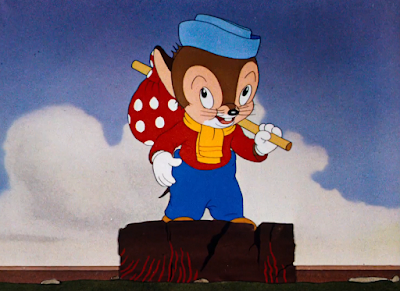







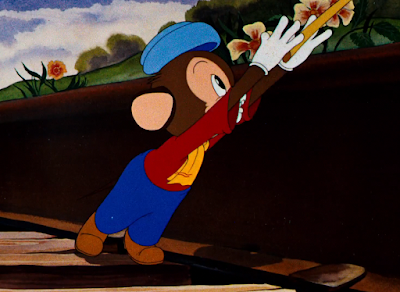


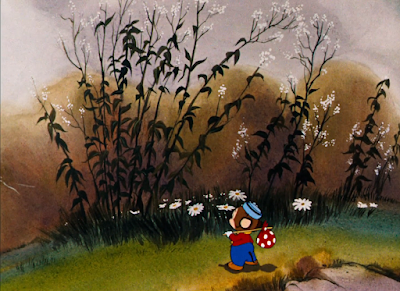
































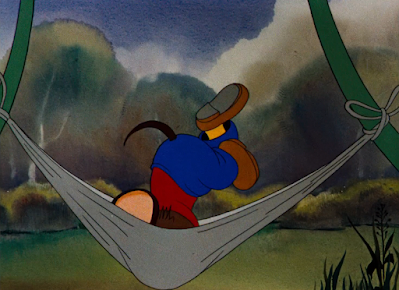









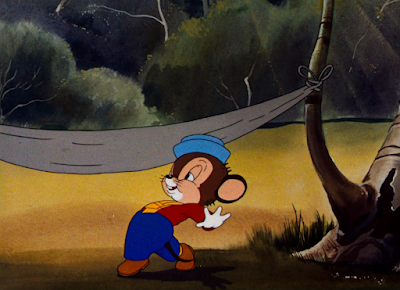












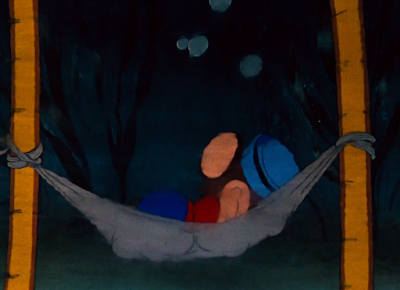























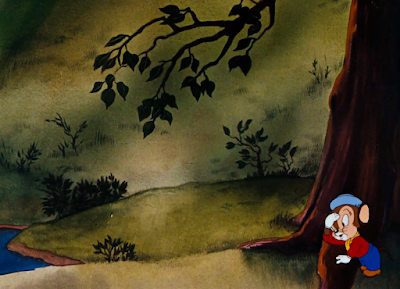

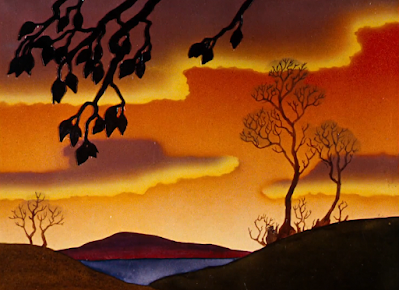





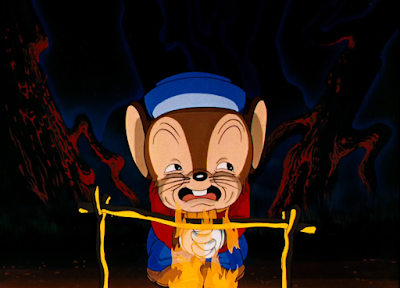


























No comments:
Post a Comment